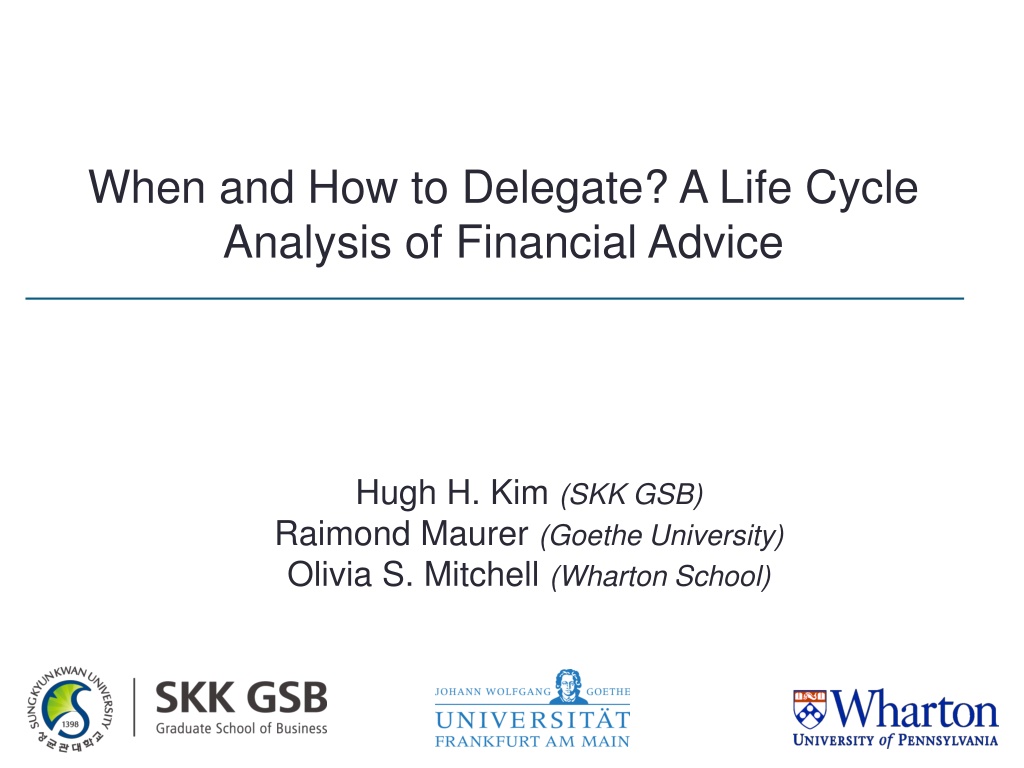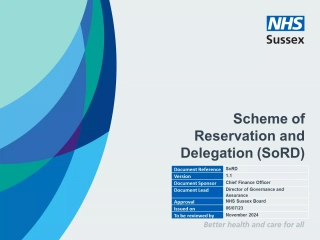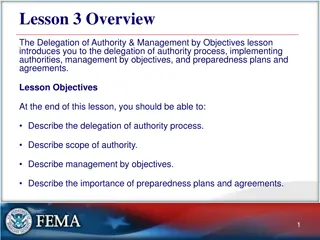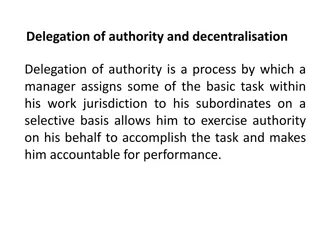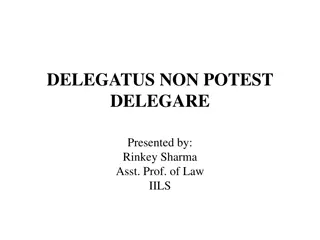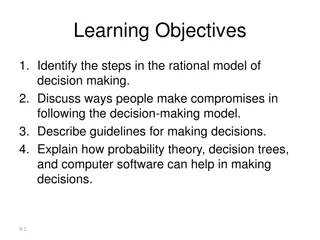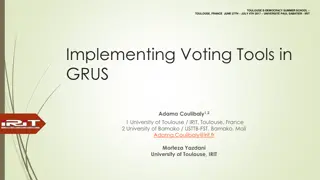Efficient Delegation in Financial Decision Making
Analyzing the life cycle of financial advice reveals that most individuals lack the time, interest, or knowledge to manage their finances effectively. Delegating financial decision-making early can be beneficial, with customized advice outperforming simple target date funds. However, delegation options provided too late may decrease welfare significantly. Understanding the constraints of time and opportunity cost in financial management is crucial for maximizing investor welfare.
Download Presentation

Please find below an Image/Link to download the presentation.
The content on the website is provided AS IS for your information and personal use only. It may not be sold, licensed, or shared on other websites without obtaining consent from the author.If you encounter any issues during the download, it is possible that the publisher has removed the file from their server.
You are allowed to download the files provided on this website for personal or commercial use, subject to the condition that they are used lawfully. All files are the property of their respective owners.
The content on the website is provided AS IS for your information and personal use only. It may not be sold, licensed, or shared on other websites without obtaining consent from the author.
E N D
Presentation Transcript
When and How to Delegate? A Life Cycle Analysis of Financial Advice Hugh H. Kim (SKK GSB) Raimond Maurer (Goethe University) Olivia S. Mitchell (Wharton School)
Motivation Standard finance theory assumes investors will change their portfolios if environment changes. But most people devote sparse attention to their financial portfolios and do not actively manage their own finances. 1
Time spent on financial planning 60% of Americans admit financial management needs improvement. Most common excuse is not having enough time (24%) Having no interest (21%), finding it confusing (20%) 2 Not knowing where to get help (19%)
Reality of Financial Management Agnew/Balduzzi/Sunden (AER 2003): Most asset allocations are extreme (either 100 percent or zero percent in equities) and there is inertia in asset allocation. Brunnermeier/Nagel (AER 2008): (..) one of the major driver of household portfolio allocations seems to be inertia A very large proportion of the population has no interest, knowledge or time to direct their retirement accounts. They are known as the unengaged majority -- The Economist (April 2011) 3
Questions and Contributions What policy options can increase investor welfare? How much value can a financial advisor deliver to inattentive investors? When can it help the most? What type: simple rule-based vs. customized advice? Why do many investors retain portfolio allocations for a long time (i.e., inertia)? Rational choice (Kim, Maurer and Mitchell, 2016) incorporating opportunity cost of time for financial decision making. 4
Our Main Results Early access to a delegation option is beneficial. A delegation option provided 10 years later decreases welfare 50%. Simple target date funds (TDF) do not beat customized financial advice in terms of welfare benefit. Simpler portfolio products would need to be provided at zero cost, in order to benefit consumers as much as a customized service. 5
Financial Decision Making Does Not Come Free: Time Budget Constraint with Investment Management Investment management Work Leisure 1 = ?? + ?? + ?? Opportunity time cost of self financial management; convex over lifetime (Agarwal et al. 2009) Generates utility Generates income and builds human capital 6
Labor Income and Human Capital Accumulation Job-specific skill (human capital) accumulated in a learning- by-doing fashion (Arrow 1962 / Becker 1964): Prior to retirement, labor income affected by work hours, human capital, and exogenous shocks Active management incurs time cost. Forgone opportunity to accumulate more human capital Portfolio inertia: retain previous period s stock balance into the next period, incurring no time cost. 7
Our Baseline Lifecycle Setting Utility of consumption & leisure ( ) 1 1 ( ) C L = + s t V E p V t t + 1 t t t Household:US female; middle income; =3; =1.3, =0.98 Labor market:Stochastic wage rate, endogenous human capital Consumption Numerical dynamic optimization; 10K life cycles simulated Labor supply/ Leisure Capital market: Risk-free bond 2%, risky stock iid N(6%, 20.5%) Financial advisors: delegation fee 1.3% of AuM Retirement (age 65): full leisure, pension benefits, shocks Asset allocation Portfolio Mgt. Method Four state variables: wealth, human capital, equity share, wage shock Solution by numerical integration using MC approach 8
Portfolio inertia over life cycle Figure 4 from Kim, Maurer and Mitchell (2016) Baseline model matches closely the empirical pattern of inertia with 2~4% of time cost for active portfolio management. 9
Fee Structure for Financial Advisory Services Type of advisory fee A percentage of asset under management (AUM) Fixed fee (other than subscription fee) Performance-based fee Hourly charges Commissions Subscription fee Other # of advisers 10,727 (94.73%) 4,661 (41.16%) 4,354 (38.45%) 3,174 (28.03%) 562 (4.96%) 128 (1.13%) 1,623 (14.33%) Source: Authors tabulation from the SEC Form ADV Our approach - variable fee: 1.41% of AUM if delegate - minimum fixed fee: $2,100 10
Policy experiments Policy experiment 1: - When is delegation most helpful? - Introduce delegation option at different ages Policy experiment 2: - Simple rule vs. customized advice - How much value does customized advice deliver? 11
Welfare Analysis of Experiments Experiment 1: When to have a delegation option? (1) (2) (3) (4) Age=20 Age=30 Age=45 Age = 60 1.07 0.51 0.19 0.02 (a) Welfare Gain Experiment 2: Welfare benefit of rule-based options Investment Glide Path (1) (2) (3) (4) Mgmt fee=0.84% Mgmt fee=0.5% Mgmt fee=0.2% Mgmt fee=0% 0.52 0.63 0.88 1.10 (a) 60% 0.49 0.59 0.84 1.06 (b) 60% 20% 0.38 0.56 0.81 0.94 (c) 100-age 0.56 0.69 0.98 1.20 (d) 80-age 12
Conclusions Early access to a delegation option is beneficial. If introduced 10 years later, welfare lowers by 50%. Simpler target date funds (TDF) do not beat customized financial advice in terms of welfare benefit. Simpler portfolio products would need to be provided at zero cost, in order to benefit consumers as much as customized financial advice. Generating alpha may not be a necessary reason to seek financial advice 13
Related Literature Optimal dynamic consumption & portfolio allocation Cocco/Gomes/Maenhout (2005); Gomes/Michaelidis (2005) Portfolio allocation with flexible labor supply Bodie/Merton/Samuelson (1992); Gomes/Kotlikoff/Viceira (2008); Chai/Horneff/Maurer/Mitchell (2011) Impact of Investor inattention on stock prices Jagannathan/Wang (2007); Dellavigna/Pollet (2008), Abel et al. (2013)
Portfolio Choice and Wealth Dynamics At time t, individual selects portion ??+1(1 ??+1) of investable wealth allocated to risky equities (risk-free bonds), portfolio generates an uncertain return of: ? = 1 ??+1? + ??+1??+1. ??+1 Dynamic budget constraint can be formulated as ? (??+ ?? ??) ??+1= ??+1 where ?? is consumption and ?? is labor earnings.
Calibrated Parameters Parameter Baseline Working periods 45 Retirement periods 35 0.98 Time discounting 3 Risk aversion 1.3 Leisure preference Experience formulation a 0.2192 Elasticity of ?? accumulation ? 0.2954 Depreciation of Human Capital ?? 0.07% age per annum Inefficiency of financial decisionmaking ? Wage shock drift 0.09 0.03 304 ? 304+0.03 0 Wage shock auto correlation 0.85
Calibrated Parameters Parameter Baseline 0.2917 Std. of permanent wage shock ????? (pre- retirement) Std. of permanent earnings shock (post- retirement) Replacement rate 0.28 20% of maximum earnings at age 65 0.04 Risk premium Std. of stock return ?????? 0.205 1.02 Risk free rate ? Delegation annual fee: variable rate ?? Delegation annual fee: fixed fee 1.3% per annum 0 Correlation between wage and stock return ??,? Initial wealth for simulation ?0 Initial human capital for simulation ?0 Initial equity share for simulation 0.15 0 10 40% Initial wage shock for simulation ?0 0.1
